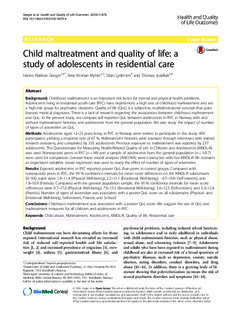| dc.contributor.author | Greger, Hanne Klæboe | |
| dc.contributor.author | Myhre, Arne Kristian | |
| dc.contributor.author | Lydersen, Stian | |
| dc.contributor.author | Jozefiak, Thomas | |
| dc.date.accessioned | 2017-08-07T09:47:43Z | |
| dc.date.available | 2017-08-07T09:47:43Z | |
| dc.date.created | 2016-08-09T14:26:08Z | |
| dc.date.issued | 2016 | |
| dc.identifier.citation | Health and Quality of Life Outcomes. 2016, 14:74 1-17. | nb_NO |
| dc.identifier.issn | 1477-7525 | |
| dc.identifier.uri | http://hdl.handle.net/11250/2450009 | |
| dc.description.abstract | Background
Childhood maltreatment is an important risk factor for mental and physical health problems. Adolescents living in residential youth care (RYC) have experienced a high rate of childhood maltreatment and are a high-risk group for psychiatric disorders. Quality of life (QoL) is a subjective, multidimensional concept that goes beyond medical diagnoses. There is a lack of research regarding the associations between childhood maltreatment and QoL. In the present study, we compare self-reported QoL between adolescents in RYC in Norway with and without maltreatment histories, and adolescents from the general population. We also study the impact of number of types of adversities on QoL.
Methods
Adolescents aged 12–23 years living in RYC in Norway were invited to participate in the study; 400 participated, yielding a response rate of 67 %. Maltreatment histories were assessed through interviews with trained research assistants, and completed by 335 adolescents. Previous exposure to maltreatment was reported by 237 adolescents. The Questionnaire for Measuring Health-Related Quality of Life in Children and Adolescents (KINDL-R) was used. Nonexposed peers in RYC (n = 98) and a sample of adolescents from the general population (n = 1017) were used for comparison. General linear model analyses (ANCOVA) were conducted with five KINDL-R life domains as dependent variables. Linear regression was used to study the effect of number of types of adversities.
Results
Exposed adolescents in RYC reported poorer QoL than peers in control groups. Compared with nonexposed peers in RYC, the 95 % confidence intervals for mean score differences on the KINDL-R subdomains (0–100 scale) were 1.9–11.4 (Physical Well-being), 2.2–11.1 (Emotional Well-being), −0.7–10.0 (Self-esteem), and 1.8–10.9 (Friends). Compared with the general population sample, the 95 % confidence intervals for mean score differences were 9.7–17.6 (Physical Well-being), 7.9–15.3 (Emotional Well-being), 3.6–12.5 (Self-esteem), and 5.3–12.8 (Friends). Number of types of adversities was associated with a poorer QoL score on all subdomains (Physical- and Emotional Well-being, Self-esteem, Friends, and School).
Conclusions
Childhood maltreatment was associated with a poorer QoL score. We suggest the use of QoL and maltreatment measures for all children and adolescents in RYC. | nb_NO |
| dc.language.iso | eng | nb_NO |
| dc.publisher | BioMed Central | nb_NO |
| dc.rights | Navngivelse 4.0 Internasjonal | * |
| dc.rights.uri | http://creativecommons.org/licenses/by/4.0/deed.no | * |
| dc.title | Child maltreatment and quality of life: A study of adolescents in residential care | nb_NO |
| dc.type | Journal article | nb_NO |
| dc.type | Peer reviewed | nb_NO |
| dc.description.version | publishedVersion | nb_NO |
| dc.source.pagenumber | 1-17 | nb_NO |
| dc.source.volume | 14:74 | nb_NO |
| dc.source.journal | Health and Quality of Life Outcomes | nb_NO |
| dc.identifier.doi | 10.1186/s12955-016-0479-6 | |
| dc.identifier.cristin | 1371517 | |
| dc.description.localcode | © 2016 Greger et al. This article is distributed under the terms of the Creative Commons Attribution 4.0 International License (http://creativecommons.org/licenses/by/4.0/), which permits unrestricted use, distribution, and reproduction in any medium, provided you give appropriate credit to the original author(s) and the source, provide a link tothe Creative Commons license, and indicate if changes were made. The Creative Commons Public Domain Dedication waiver(http://creativecommons.org/publicdomain/zero/1.0/) applies to the data made available in this article, unless otherwise stated. | nb_NO |
| cristin.unitcode | 194,65,35,0 | |
| cristin.unitcode | 194,65,20,0 | |
| cristin.unitname | Regionalt kunnskapssenter for barn og unge - Psykisk helse og barnevern | |
| cristin.unitname | Institutt for samfunnsmedisin | |
| cristin.ispublished | true | |
| cristin.fulltext | original | |
| cristin.qualitycode | 1 | |

